Fall 2012–Grand Canyon
23 September
More Rim Stuff
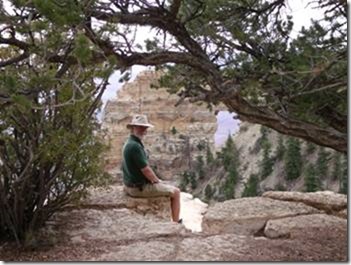 Yesterday we drove/hiked out to Angel’s Window, a natural break-through in the wall of a vertical ridge. Not only is it a marvelous feature in itself, but the view from atop the Window shows many angles off into the Canyon.
Yesterday we drove/hiked out to Angel’s Window, a natural break-through in the wall of a vertical ridge. Not only is it a marvelous feature in itself, but the view from atop the Window shows many angles off into the Canyon.
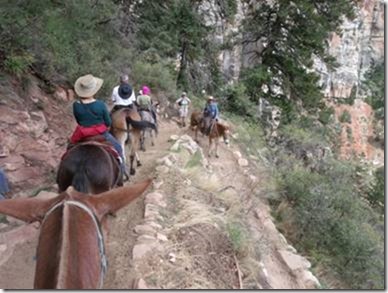 Today, we decide to blow a few bucks and try out the half-day mule ride. This takes us down 2000 feet into the Canyon, in a pack train with 8 other stalwarts and a feisty lady guide (Kitty). The Kaibab Trail has switchbacks like I’ve never seen before, 179-degree turns that place you 10 feet horizontally and 20 feet vertically from the mule above you. The mules go head-first into the turn, then pace in place like a 4-legged turntable until they are pointed downhill again.
Today, we decide to blow a few bucks and try out the half-day mule ride. This takes us down 2000 feet into the Canyon, in a pack train with 8 other stalwarts and a feisty lady guide (Kitty). The Kaibab Trail has switchbacks like I’ve never seen before, 179-degree turns that place you 10 feet horizontally and 20 feet vertically from the mule above you. The mules go head-first into the turn, then pace in place like a 4-legged turntable until they are pointed downhill again.
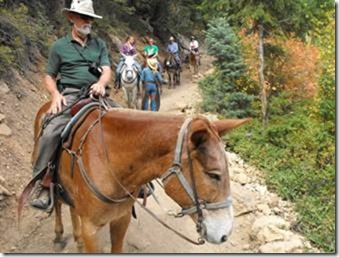 The gal behind me had never ridden any horse or mule before, and was okay-comfortable. But her mule was one which would lag back <if the rider allowed>. No matter how much Kitty exhorted her to swat the mule with her rein, she just couldn’t bring herself to it, and Kitty spent many minutes going back to re-instruct her, and eventually just waiting for the gray mule to catch up. No worries though, everybody including Kitty took it cheerfully.
The gal behind me had never ridden any horse or mule before, and was okay-comfortable. But her mule was one which would lag back <if the rider allowed>. No matter how much Kitty exhorted her to swat the mule with her rein, she just couldn’t bring herself to it, and Kitty spent many minutes going back to re-instruct her, and eventually just waiting for the gray mule to catch up. No worries though, everybody including Kitty took it cheerfully.
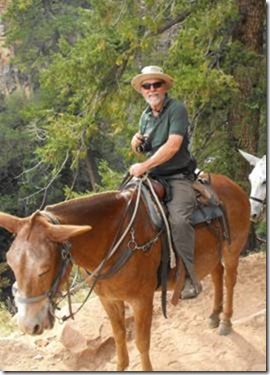 Every once in a while, my hat brim gets flipped up by a gust of wind, or by trying for a vertical-format camera shot. When this sad event happens, my appearance changes radically, from a that of a reasonably manly world-traveler (I think), to a one of a simple grinning idiot. Karin can barely contain her laughter looking at this shot, and has to wipe away her tears, so I just had to share it, despite my embarrassment.
Every once in a while, my hat brim gets flipped up by a gust of wind, or by trying for a vertical-format camera shot. When this sad event happens, my appearance changes radically, from a that of a reasonably manly world-traveler (I think), to a one of a simple grinning idiot. Karin can barely contain her laughter looking at this shot, and has to wipe away her tears, so I just had to share it, despite my embarrassment.
Going down into the Canyon is familiar in some ways, and strange in others. From a trail perspective, it is similar to navigating a steep mountain slope. But it’s a slope that never rolls off or tops out. Looking down into the Canyon, however, is a world apart from mountain-climbing. The sense of being suspended in geological history is unmistakable, and I find myself wishing to understand more of the layers that make up our remarkable plunge back into Time.
North Rim Explorations
For the last three days, we’ve “commuted” from our camp in DeMotte campground, going in and out of the Park where camping is booked solid for the entire season, 6 months in advance. (Not very consistent with extemporaneous travel.) But DeMotte was convenient and affordable, and most important it could be navigated to in the dark after a day’s explorations. So we based there to spoke out to various attractions.
At the North Rim, the most surprising (practical) element for us has been the near-total lack of Internet connectivity. Even the NP campground store had its wifi down, and we scraped through with fragments of 3G, 1X (gag) and long waits for slow uploads. I’m very glad that I chose to use files with embedded pix instead of uploads to Facebook. I’d still be sitting on the porch of Grand Canyon Lodge, waiting for that ephemeral second 3G bar….
Traveling, the way we are doing it, has an appreciable element of mental exercise. I doubt that there is one day that goes by that I don’t learn some thing new and interesting, and usually it’s several things. Today, for example, I became acquainted with the following errata:
- Mules are tougher than horses; a horse would blow-out his front bones and sinews in 1-2 years on the steep Kaibab trail, but mules can work it daily for 10-12 years without deterioration.
- Mules are smarter than horses. You could scare/startle a horse into jumping off a trail or even a cliff; a mule will look the situation over and say “no way Jose” and keep the rider (and the mule) safe.
- Mules WILL spook, however; we were cautioned to tie on our hats, or “you’ll get a lot more ride than you paid for”.
- The record rim-to-rim run by a human on the Kaibab trail is under 8 hours (this includes more than 20 miles of trail, and the 5000 foot climb).
- The Kaibab Trail was built by CCC workers.
- Trail-ride wranglers work many different jobs, from front-desk to shuttle-driver and of course trail guide. Many work at odd jobs off season; Kitty roasted almonds last winter.
After these last few active days, we “escape” to the East Rim. This area is comparable in some ways to the western boondocking sites from last week, but it’s closer to H67, like 5 miles instead of 20 on rough dirt roads. We have left the tourists and the pavement, left the hollering teenagers of a public camp, left the convenience and safety of facilities, gas, food, stores, etc. for the solitude and peace of a forest camp. Once again, we are camped for free, in a national forest, at the side of a dirt road and less than 50 yards from the precipice of one of the seven wonders of the world. The view is different, a broader and more-distant geology in evidence over here.
Campfires
Tonight, as with many nights, we light a campfire. Sometimes we use our own wood, which we pack along for those evenings when we really want a fire and no wood is to be found. As often as possible, we use local wood. As a matter of principle and frugality, we never buy firewood (typically $8-10 a bundle for enough wood for an hour or so).
Why a fire? We have a perfectly functioning (mostly) motorhome with insulated walls, a heater, warm clothing and blankets – – – what practical purpose is there in a fire? Well, none actually. We don’t use it to get warm or cook. Matter of fact, on really cold evenings we don’t bother with a fire, the RV is way too cozy.
No, a fire is essentially an emotional experience. There is something about that flickering, dynamic glow that connects one’s spirit with the ghosts of hunter-gatherers past. There is an elemental, mesmerizing fixation that occurs as soon as the flames rise from the wood. Conversation tends to pause, and the campers around the fire often let many minutes pass without speaking. (Really.) This connection, this hypnosis, this immersion in the fire – – – that’s why there are campfires. Doesn’t have anything to do with practicality.
Then, there are the fire-fiddlers. These are the people who simply cannot allow the blaze to burn naturally and un-influenced. Lopsided or sputtering, or even perfectly balanced for that matter, the fiddler must – – – fiddle. Move that little piece a bit over there, tuck that ember back under the edge, put another log just over that hot spot – – – the variations are endless. There are two such fiddlers in our family of two, but Karin wins the prize for focus, persistence, and nit-picking. I’m a complete amateur by comparison.
The Africans have a word in Swahili (I’ve forgotten it) that translates to “dreaming the fire”. Too bad there’s no English equivalent.
24 September
Not Enough Superlatives
I’m out of words; I seem to have used up my high-flying adjectives too early in this trip. Our camp is unbelievably beautiful, as is the weather and the terrain. We hike and bike around the area (couple of miles), exploring this strip of roadway and trails and camps that flank the East Rim. Every turn is a delight. Here’s a dragon’s-back formation down several thousand feet from our position, miles long. I would have called it a sea-serpent, but it’s named the Cocks Combs. I’m standing on a precipice that drops several hundred feet straight down to the slope below.
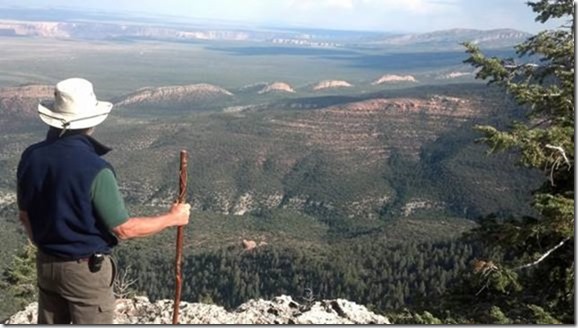
There are many places on the trail where the foliage just opens wide and there’s a huge vista of the plateau, receding into the distance toward Page and Lake Powell more than a hundred miles away.
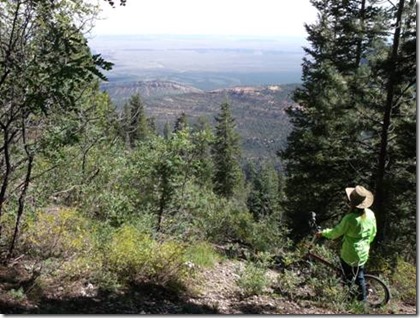
As we explore, we find a super-camp even better than the one we parked in last night, and we move down the road a few hundred yards to our best camp yet on this trip. Trees and brush are sparse, and we can view the canyon directly from our front seats in Howie. Life is good.
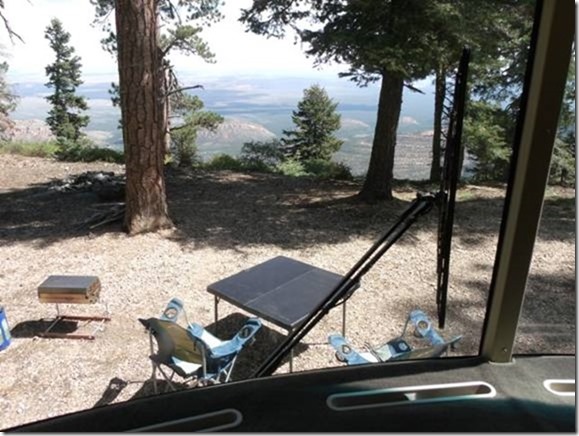
In the afternoon, air-mass rain-clouds pass through, delivering small showers, shade to defeat our solar system, and some nice cloud/sky contrasts. In the evening, the clouds drift off into the distance, and after dark we get some brilliant lighting displays that are so far in the distance we never hear the boom.
Water
As it turns out, water is our gating resource as we travel, even more than gasoline in a way. We start out with around 75 gallons, a big tank under our bed. Because it’s the one thing that we can’t re-charge, and we have to find the right kind of civilization to replenish it, we are very frugal with it.
A little non-intuitively, most of our water actually stays with us, in either the gray-water holding tank (shower and sink) or the black-water holding tank (toilet). So the enterprise of picking up some more water also has to involve dumping our accumulated holding tanks, and this always requires a formal dump station. These are to be found in all national parks, some state parks, most private RV campgrounds, and a few other places. Dumping gray water by the side of the road, or in an empty unpopulated spot, is not too great a sin, but dumping black water anywhere but in a designated receiving tank is a horrible transgression.
Because we like to stay “out in the boonies” whenever possible, we have to watch carefully when we’re nearing our tank limits, and make sure we reach an appropriate facility before we run empty/full, as the case may be.
To conserve water, we have long-since converted to paper dishes. We also observe some conservation techniques:
- The GI shower – wet down, shut off. Soap up. Rinse quickly. Done.
- Use the shower warm-up water (waiting for hot) to fill the toilet bowl for the next flush.
- Shower head is a special low-volume, wide-spray type.
- Use only a trickle for teeth-brushing.
- NEVER let a faucet run-on for any purpose.
It’s surprising how long you can make your resources last when you really try. Our last leg used about 55 gallons of our supply, and it covered 11 days of our trip. Could probably have stretched it to 14 days. That’s an average 5 gallons per day for all flush-toilet and stand-up-shower use for two people who use both facilities every day. Well, it’s not back-packing, but it’s not bad.
25 September
Continued Excellence
The day dawns clear, with the sun rising above the 100-mile-wide plateau stretching out in front of our camp. It’s 42F outside and we warm up the coach with our trusty forced-air heater (I told you it wasn’t backpacking). I cook up my first cup of coffee, go outside and put a camp chair in the warm sunlight, settle down and enjoy this soothing combination of close woods and wide open vastness. What a treat.
Yesterday afternoon, we see an odd “adventure” vehicle roll past, with an assortment of bicycles and racks. On our evening walk, we saw it parked down the road in a nice camp site. This morning just after breakfast, a series of riders roll past on the access road, including a red tandem mountain-bike with full suspension.
Ravens
The raven and crow are often mistaken for each other, and it’s taken me a while to clearly distinguish between them. In short, I’m annoyed by crows and charmed by ravens.
The crow comes in loud, raucous flocks, harsh, repetitive, irritating calls, and a bullying attitude that (in my back yard) scares away the “nicer” birds like songbirds, finches, etc. Male crows will battle nearly to the death over a female, swirling and battling above the gal and generally raising Hell in the neighborhood.
The raven doesn’t flock, is generally seen in singles or pairs, and mates for many seasons or even a lifetime. They have an absolutely amazing variety of calls, it’s really fair to call them voicing’s, ranging from a baby’s coo to a deep guttural croak to a strange knock-on-wood clatter, and many, many variations in between.
Ravens are about 50% larger than crows, although this is difficult to observe because they are almost never found together. The raven’s tail is somewhat pointed, while the crow’s is somewhat blunt; but individual variations make this an iffy identification. The best way I’ve found to identify the raven from the crow is its beak. It has a distinctly curved upper beak, large and heavy, whereas the crow’s beak is straight and more slender and pointed.
When we encountered ravens on the South Rim, they were inordinately tame, spoiled and fed by tourists. They would routinely approach us within 3-4 feet, making soft little cooing noises to beg for handouts. Here on the North Rim, they are completely the opposite, wild and spooky. I can’t even get a picture of one, they fly away as soon as I peek around the trunk of a tree to look at them 100 feet away. Also here we have heard even more variations in their call. One sound really was puzzling, akin to taking two pieces of hardwood and knocking them together in quick succession. Amazing birds.
Beauty, Love, Tragedy, Continuance
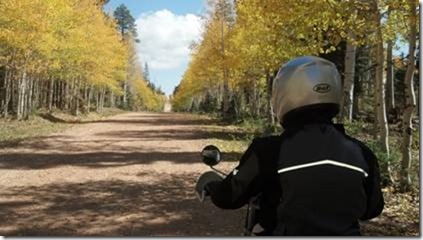 We do a lot of exploring this day, more than 50 dirt miles on Papoose. The aspens flank many of our roadways, and the yellows are turning to golds and reds as the night-time temperatures continue to lower.
We do a lot of exploring this day, more than 50 dirt miles on Papoose. The aspens flank many of our roadways, and the yellows are turning to golds and reds as the night-time temperatures continue to lower.
One spur road takes us out to Marble View, a 180-degree open area that presides over the eastern portion of the Canyon, and it’s turn to the north toward Page and Lake Powell.
As we walk around the wind-swept knoll, Karin spots a distant cairn of rocks, quite imposing at about 6 feet in height. We walk over to it, and marvel that some of the pieces in the cairn must weigh at least 60 or 80 pounds, fairly difficult to lift up 4 or 5 feet on top of the pile of rocks. On the Canyon side of the cairn, we spot a well-preserved 50-cal ammo can, obviously a weather-proof container for some treasure. At first, we think we’ve stumbled onto a geocache. Since neither of us participate in geocacheing, we open the box to see what secret it holds.
The box contains only a notebook and some pictures. The pictures show a handsome young couple, with a calm, confident man, clean-shaven with short-cropped hair. His companion is a brilliantly pretty young girl, with the kind of joy and spirit that beams from the page and transcends ink-jet-on-paper. Both are clearly slim, fit, healthy outdoor adventurers in a multitude of scenic backgrounds, obviously enjoying each other and their surroundings.

The notebook was faintly titled:
- Ioana
- Elisa
- Homaciti
and the front page quietly stated:
Memorial – – please do not remove or destroy
Ioana was a Rumanian-born girl who moved to the US to go to college. Here she met her true love, and together they traveled the US and Europe on a shoe-string while she pursued her degree in math and biology. They became expert hikers and backpackers, and the Grand Canyon was one of their many inspirations.
In 2010, they were married on the knoll at Marble View, with the Canyon and some friends and family witness to their vows. They continued their love of travel and back-country hiking into their married life. Less than a year later, Ioana was walking in a new area of the Canyon on one of their many excursions. Keeping prudently 20 feet away from the unknown edge, she stepped on a large rock which was hiding a deep chute. The rock gave way, and Ioana fell into the chute. The first impact knocked her unconscious and the fall killed her instantly.
In the Spring of 2012, her husband returned to Marble View and built the memorial rock cairn. He wrote the notebook memoriam, including some history of their time together. Many other visitors have left their own comments in the notebook, most of the pages spotted or stained with the leavings of tears. I started to read the words, but my own tears made it impossible to continue. I considered adding my own thoughts or comments, but anything I could think of seemed small and trite, compared to the tragedy, and to those who had made comment before me. I decided to put my own memoriam down here, in our travel journal, to share with friends and family the depth of what we experienced.

I can only imagine, as I sit here typing, and weeping from my emotions and thoughts of the depth of sadness that this beautiful soul left behind. More than a pretty girl, I have seen a person whose vibrant joy in life, and love for her man, was without bound. And I also see this: the vast differences of the joyousness of her life, and the sadness of her death, join and blend together in a way that is like the diverse character of the Canyon that surrounds it all. Life, love, death, loss, red, green, blue, bronze, rock, river, canyon, plain – – harmony and maelstrom, delight and pain, an impossible-to-describe mix of the pieces of existence.
All of our lives are precious, and yet fleeting – – and the Canyon, for all its immenseness of space and time, is really no more permanent. All these elements, here in this remote land, seem to me to weave themselves together, in an exquisite combination of the Now and the Infinite that all of us in some way seek.
The poignancy of this couple’s short time together compels us to try to draw some wisdom, some conclusion. There will be some who regard their brief chapter as divinely guided; others will see it as just another random quirk of an infinite universe. But no matter, there is still the one undeniable message…..
In Ioana’s husband’s words, lovingly penned by hand in the front of his memoriam, “Live and love to the fullest possible. Hold your lover’s face in your hands, and tell them whenever you can how you feel about them. Laugh, talk, travel, work, and play together in appreciation of what you have.”
I do not interpret his words as a threat, “because some day you won’t have it”. All of life is transient, and I feel his message is a re-affirmation of something I believe in profoundly. It is that living deeply and fully, each and every moment of each and every day, is the highest responsibility that we have.
I hope these words have not saddened you too much, but perhaps “just enough”. A passage like this is somewhat unusual to find in a travel journal – – but it’s my journal, and this is one of the things that I want to share.
26 September
Paths Crossing
Late yesterday afternoon, a lone car paused at our camp entrance road, and then slowly drove in, obviously reconnoitering the area. Our camp is quite large, about 3 acres or more, and there was plenty of room for another visitor without crowding each other. We approached each other in greeting.
Peter and Beatrice were a Swiss couple, out for a week’s drive through Arizona. Their German-accented speech was, as usual, a friendly call to Karin’s native tongue, and we immediately began to get acquainted. Not with my primitive German, for sure – – “Entshuldegen zie, mein deutch ist nitcht ser gut” (excuse me, my German is not so good) is about the only German I normally utter. In fact, I’ve spoken it so well that the people we encounter don’t believe me at first, until I steadfastly stick to English after my initial apology.
Fortunately, both of our new acquaintances are far more adept at English than I am German, and we manage to have a lively conversation. Our chatting reveals remarkable similarities in backgrounds, ethics, philosophies, and even our personal medical backgrounds. Peter and I have both been recently diagnosed with stage-1 prostate cancer; we’re both gluten-sensitive; Beatrice and Karin have the same birthdate, similar family thoughts and values; Peter and I are both dyed-in-the-wool fiddlers/fixers/inventors; the list goes on.
In short, we have, out here in the remote wildness of the Arizona Strip, found a pair of compatible spirits. It’s not unheard of to meet strangers and make friends quickly and often while traveling, especially if one is not of the rough-edged sort; but such acquaintances are typically in-passing and don’t ordinarily become a lasting part of one’s life. Here, we have a different sense of this meeting, new and special people with whom we are likely to become and stay close friends.
We exchange addresses and emails and promises to exchange photos, messages, and visits, with far more intensity and sincerity than any casual encounter. We both know that there is a friendly guest room in Switzerland, and in California, for whenever our physical paths may cross again. After they leave to continue their short trip (relative to ours), we feel an unusual sense of lonesomeness and separation. What a wonderful gift we have received, in addition to all the grandness of the natural world around us.
Time to Travel
This morning, the day dawned bright and beautiful, with a puffy cumulus-dappled sky and nearly calm air. We all chatted some more, and enjoyed a BBQ-sausage breakfast with (of course) gluten-free toast lovingly pan-fried by Karin.
As the morning waned, the clouds began to enlarge and gang together, and this afternoon the sky is completely closed off and light-gray to the horizon. The vast Canyon is flat, its colors and textures unrevealed; Howie’s solar panels are sleeping too peacefully in the gloom and our batteries are pining away for some charge that is not likely to be forthcoming. The temperatures have been dropping too (34F this morning), and so we must run the heater a bit all night, further depleting our batteries.
Evening brings on clearing skies, and soft cumulus mark the darkening blue to the east. Our ridgeline rolls its shadow across the Cocks Combs, and continues to cloak the vast plateau whose center has been scoured away by the upper Colorado. It looks like tomorrow is a good day to leave for Page.
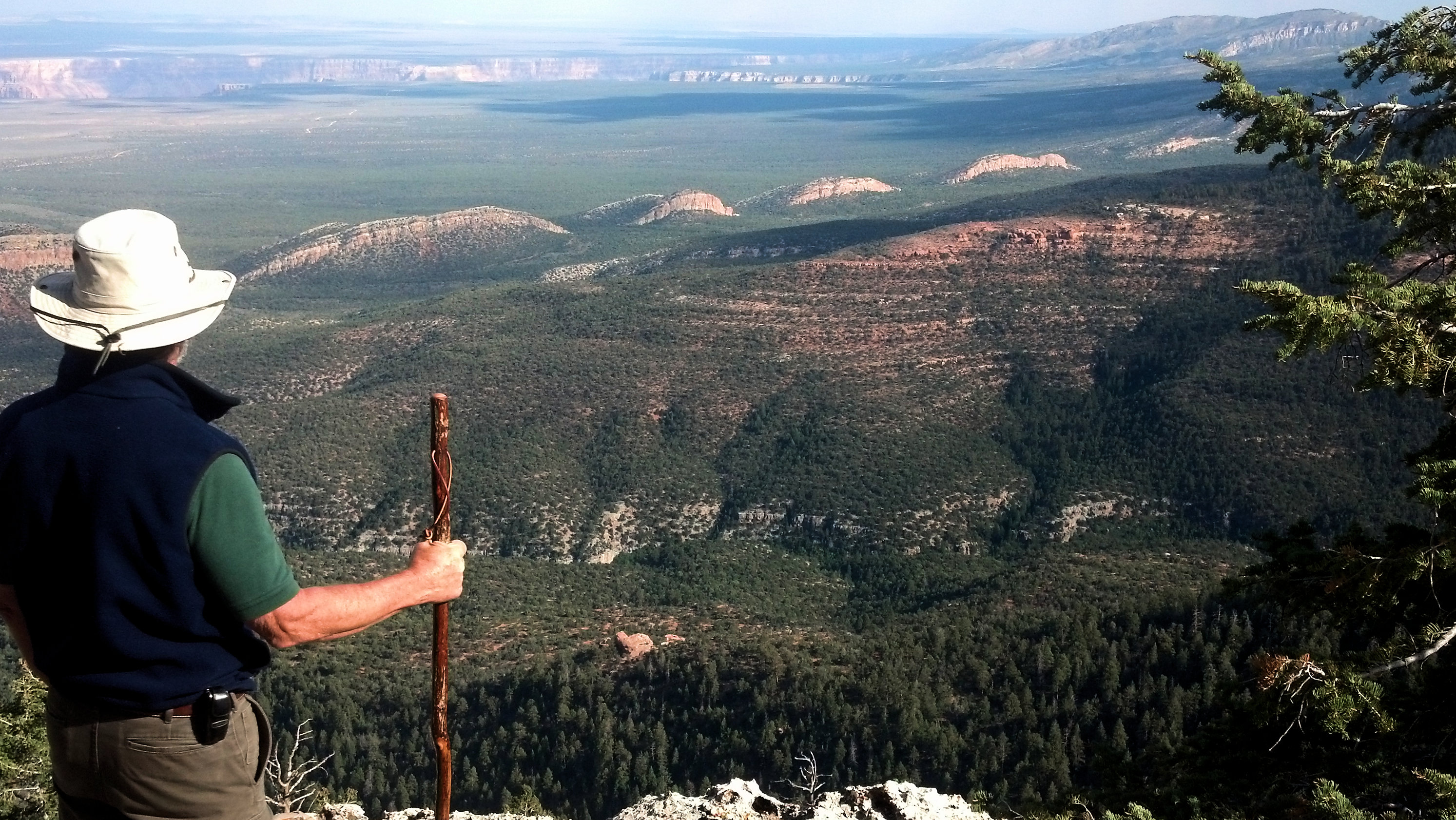
Comments
Fall 2012–Grand Canyon — No Comments
HTML tags allowed in your comment: <a href="" title=""> <abbr title=""> <acronym title=""> <b> <blockquote cite=""> <cite> <code> <del datetime=""> <em> <i> <q cite=""> <s> <strike> <strong>